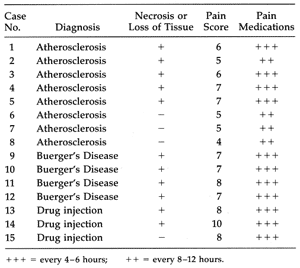 Articles
- Research relating to ETS
Articles
- Research relating to ETS
Thoracoscopic Sympathectomy for Upper Limb Ischemia
|
Download Article (Adobe PDF) | Download Free | |||
De Giacomo et al: Thoracoscopic Sympathectomy for Symptomatic Arterial Obstruction of the Upper Extremities. Ann. Thorac. Surg., 885-887, 2002.
Thoracoscopic Sympathectomy for Symptomatic Arterial Obstruction of the Upper Extremities
Tiziano De Giacomo, MD, Erino A. Rendina, MD, Federico Venuta, MD, Domenico Lauri, MD, Edoardo S. Mercadante, MD, Marco Anile, MD, and Giorgio F. Coloni, MD
Division of
Thoracic Surgery and Division of Vascular Surgery, University of Rome “La
Sapienza,” Rome, Italy
Background. Severely symptomatic arterial
insufficiency of the hand and upper extremities requires adequate
treatment. Medical therapy and local care are usually unsuccessful,
and thoracic sympathectomy can represent an effective procedure
to control pain, to help ulcer healing, and to prevent or delay
amputation.
Methods. We performed 20 thoracoscopic sympathectomies in 15 patients (13 men and 2 women) with upper extremity ischemia. Mean age was 47 years (range 21 to 72 years). All patients were thought to have organic block l age of digital arteries. The condition was unilateral in 10 patients and bilateral in 5. Primary diagnosis was digital arteriosclerosis in 8 patients, Buerger’s disease in 4 patients and the remaining 3 were drug abusers with severe ischemia due to accidental intra-arterial injection of drugs. Eleven patients (73%) presented with terminal digital necrosis, gangrene, or ulceration of the fingers associated with severe pain. Four ~patients complained of coldness, pain, and some degree of soft tissue infection without permanent loss of tissue.
Results. We performed 10 unilateral and five bilateral staged (mean interval was 3 months) thoracoscopic sympathectomies. We had two minor complications and no mortality. Mean duration of postoperative chest drainage was 2.5 + 0.4 days and mean postoperative hospital stay was 5.3 + 0.5 days. Follow-up ranged from 3 to 71 months, with a mean of 33 months. All patients demonstrated clinical benefit after operation.
Conclusions. Thoracoscopic sympathectomy in patients with severe ischemia of upper limb extremities permits optimal symptomatic control and maximum tissue salvage. Because the procedure is minimally invasive, safe, and associated with a low rate of complications, it should be considered earlier the natural course of this disease.
Thoracic sympathectomy has been substantially improved with the use of video-assisted thoracoscopy (VAT) because it offers better visualization of the anatomic structures with minimal invasiveness [1-3]. Major indications include hyperhidrosis [4], Raynaud’s disease [5], causalgia [6], and reflex sympathetic dystrophy [7]. A less common indication is represented by symptomatic vascular insufficiency of the upper extremities due to arterial obstruction, when revascularization is not feasible because of the peripheral location of the lesions [8]. In this subset of patients, sympathectomy induces the release of vasomotor control and hyperactive tone of the small arteries and arterioles, improving circulation to the skin, peripheral extremities, and bone, allowing healing of ulcers and trophic lesions and limiting tissue necrosis [9]. Because little information is available in the literature about the efficacy of VAT sympathectomy in this subset of patients, we describe our initial experience.
Patients and Methods
From January 1995 to December 2001, we performed 20 VAT sympathectomies in 15 patients with upper extremity ischemia. Thirteen patients were male and 2 female, with a mean age of 47 years (range 21 to 72 years). All patients were referred to our department with clinical and radiologic evidence of organic blockage of digital arteries unresponsive to maximal medical therapy and not treatable with direct surgical revascularization. The condition was unilateral in 10 patients and bilateral in 5. Primary diagnosis was digital arteriosclerosis in 8 patients, Buerger’s disease in 4, and the remaining 3 were drug abusers with severe ischemia due to accidental intra-arterial injection of drugs. Eleven patients (73%) presented with terminal digital necrosis, gangrene, or ulceration of the fingers associated with severe pain. Four patients complained of coldness, pain, and some degree of soft tissue infection without permanent loss of tissue. Severity of pain was evaluated preoperatively and post operatively using a visually presented numeric rating scale: |
 |
|
Table 1. Primary Diagnosis, Preoperative Presence of Necrosis or Permanent Loss of Tissue, Severity of Pain Score, and Need of Pain Medication. |
||
| TOP | NEXT |
|
 |
|